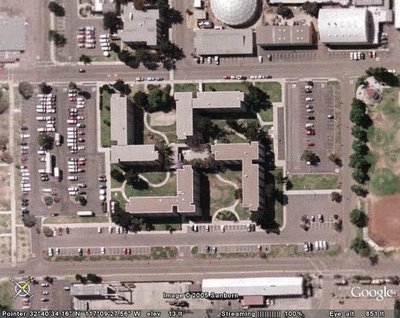
Weird choice in a building design.

I dunno. It looks like a naked woman to me.
It appears to be 4 L shaped buildings with an open area in between. You have to connect the open area in order to get near any Nazi symbol IMO.
Un-holy crappola. What a lousy design. Sickens me to see that in America. Anywhere.
The US Navy needs to tear this building down pronto!
Perhaps designed by a Buddhist?
Oh, just a little trick Hitler played during the war!!! :-)
It wasn't constructed by the Nazi party.
It's not a symbol.
Let me repeat, it's not a building ~ it's 5 buildings.
Plus, best of all, looking up from ground level, if it resembles anything, it resembles the Indian swastika, which goes the other way. Only a doufous who thought he could fly over this place would see it from the wrong perspective.
Only Islamofascist spies would actually try to fly over the Navy base.
Oh I have seen that before. It is referred to as the Mel Gibson complex.
PHOTOSHOP. Add a blog, and the fun just begins.
Take pictures of the moon or Mars...and you can sell books just like Hoagland.
Cash in on the latest Concentration Camp USA conspiracies.
Or create those pesky Russian troops occupying Iowa.
Wanna get hits to your blog? Create a swastika anywhere with our new NaziPanic plug in.
From Wikipedia, the free encyclopedia
The swastika (from Sanskrit स्वस्तिक svastika) is an equilateral cross with its arms bent at right angles in either left-facing (卍) or right-facing (卐) direction. The swastika is a holy symbol in Hinduism and Jainism. In the West, it is most widely known and used as a symbol of Nazism. It is traditionally oriented so that a main line is horizontal, though it is occasionally rotated at forty-five degrees. The Hindu version is often decorated with a dot in each quadrant.
A "right-facing" Swastika in decorative Hindu form
The motif seems to have first been used in Neolithic Eurasia. The swastika is used in religious and civil ceremonies in India. Most Indian temples, entrance of houses, weddings, festivals and celebrations are decorated with swastikas. The symbol was introduced to Southeast Asia by Hindu kings and remains an integral part of Balinese Hinduism to this day, and it is a common sight in Indonesia. The symbol has an ancient history in Europe, appearing on artifacts from pre-Christian European cultures. It was also adopted independently by several Native American cultures.
In the Western world, the symbol experienced a resurgence following the archaeological work in the late nineteenth century of Heinrich Schliemann, who discovered the symbol in the site of ancient Troy and associated it with the ancient migrations of Proto-Indo-Europeans ("Aryan" people). He connected it with similar shapes found on ancient pots in Germany, and theorised that the swastika was a "significant religious symbol of our remote ancestors," linking ancient German, Greek and Vedic culture.[1] [2] By the early 20th century it was widely used worldwide and was regarded as a symbol of good luck and auspiciousness.
The work of Schliemann soon became intertwined with the völkisch movements, for which the swastika was a symbol of "Aryan" identity, a concept that came to be equated by theorists like Alfred Rosenberg with a Nordic master race originating in northern Europe. Since its adoption by the Nazi Party of Adolf Hitler, the swastika has been associated with fascism, racism (white supremacy), World War II, and the Holocaust in much of the West. The swastika remains a core symbol of Neo-Nazi groups, and is also regularly used by activist groups to signify the supposed Nazi-like behaviour of organizations and individuals they oppose.
The word swastika is derived from the Sanskrit svastika (in Devanagari, स्वस्तिक), meaning any lucky or auspicious object, and in particular a mark made on persons and things to denote good luck. It is composed of su- (cognate with Greek ευ-, "eu-"), meaning "good, well" and asti a verbal abstract to the root as "to be"; svasti thus means "well-being". The suffix -ka forms a diminutive, and svastika might thus be translated literally as "little thing associated with well-being", corresponding roughly to "lucky charm", or "thing that is auspicious".[3] The suffix -tika also literally means mark; therefore a sometimes alternate name for swastika in India is shubhtika (literally good mark). The word first appears in the Classical Sanskrit (in the Ramayana and Mahabharata epics).
Alternative historical English spellings of the Sanskrit word include suastika and svastica. Alternative names for the shape are:
My comments: The Swastika has been around for a very long time. It's a shame that the Nazis appropriated it as their symbol, thus demonizing it and obscuring the original meanings. Sort of like what the KKK did to the Rebel battle flag. You can read about the History and more here: Swastika